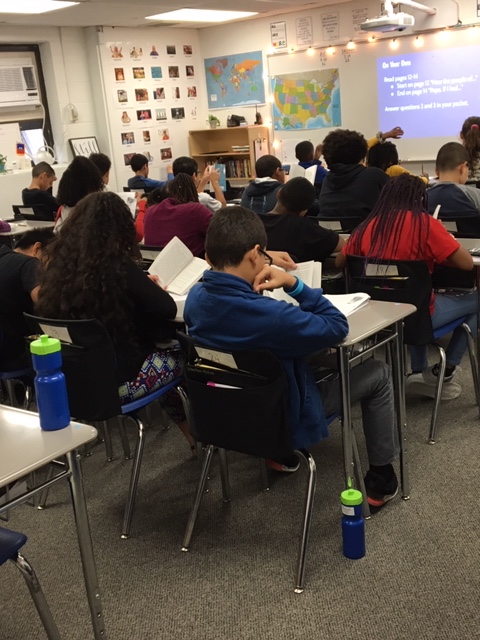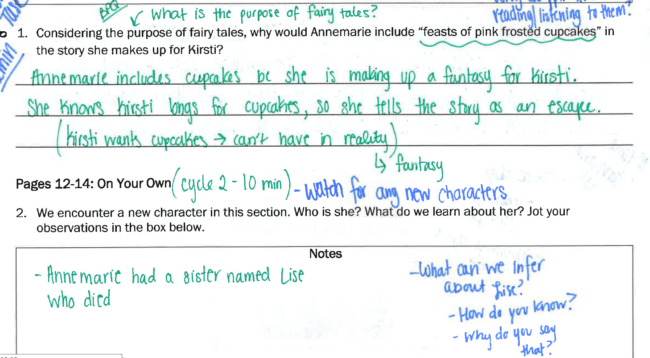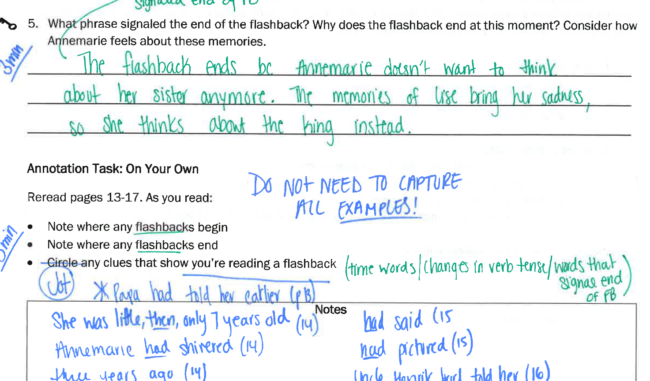10.13.19Lesson Preparation: How Christine Torres Prepares To Teach

(Note vocab wall in distance)
A few weeks ago I began work on the latest revision to Teach Like A Champion, what will become version 3.0 in about a year’s time. One of the biggest changes will be with Chapter 4, which is going to shift focus from Lesson Planning to Lesson Preparation, which are the things you do after your lesson is planned but before you teach it to ensure it’s success.
Lesson Preparation is critical whether you have written your own lesson or are using one developed for you, and this has been on my mind a lot lately because, my colleagues and I are writing an English curriculum with daily plans and we want to help teachers to prepare to teach them well in a sustainable way.
With that in mind, Colleen Driggs and I visited Springfield Prep on Friday. It’s an absolutely beautiful school in Springfield, MA that is warm and welcoming and orderly and scholarly. They use our curriculum and we wanted to see it in action. We were optimistic but we were still not prepared to be blown away by Christine Torres and her co-teacher Kait Smith. Their lesson on Lois Lowry’s Number the Stars was nothing short of spectacular: 27 hugely engaged kids reading deeply, writing consistently, and wrestling insightfully with questions like why Annemarie includes a cupcake with pink frosting in the fairy tale she tells her little sister.
Torres led the lesson and Smith pulled a small group to the back of the room where they did the same lesson but with a slightly greater degree of support during the periods of reading. Kait would read with her group carefully and attentively during the ten minutes of reading that were independent for the rest of the class, but when it was time to discuss, the three students in her group turned around in their seats and participated in the larger discussion, during which Torres called on them as much as other students. I have rarely seen support for struggling readers so effectively coordinated into a daily lesson.
But I keep digressing (really everything in their classroom deserves a happy digression). I want to share Christine’s Lesson Preparation document, which is attached. This is her copy of the packet students were working out of during the lesson. She filled it out in advance. Here are some highlights:

In this screen shot, Christine has written out an exemplar in green–this is the answer she hopes a typical successful student in her class will give. I think it’s the single most important step in preparing to teach. When you know what you are looking for, you can be more attentive to quality and you can spot the gaps between all the way right and partially correct. In fact, you can see Christine doing that here. She wants students to get to the following understanding: Annemarie includes cupcakes bc she is making up a fantasy for Kirsti. She knows Kirsti longs for cupcakes, so she tells the story as an escape. It’s a fantasy cupcake in lieu of the real thing.
Having thought this through she can start thinking about what she’ll do if they don’t get there. You can see the letters “BPQ” or back pocket question written above the exemplar. A back pocket question is a question you think up for when students struggle… a Break It Down question if you’re a TLAC reader. Having just read a piece of embedded nonfiction about how fairy tales are a form of escape, Christine hopes to help them see that by asking about the purpose of fairy tales. In blue, on the right, she’s gone a step further, another question to Break It Down a bit more if students still struggle: “Why do people like listening to them (i.e. fairy tales)?” Responding effectively to struggle is tough, but Christine did so beautifully in class in part because she had done a lot of her thinking in advance.
You can see a similar process on the next question. Students read two pages on their own and take notes in the box. By far the most important thing to take from those two pages is to understand that Annemarie had an older sister, Lise, who has died. This is revealed indirectly by the text. Again you can see Christine’s notes to herself. In this case the ideal answer is pretty straightforward but the prompts to get students there are trickier… you can see her questions in blue.
As it happened when she taught the lesson, her kids nailed it and almost every hand shot up to explain so Christine was able to focus them on describing the evidence: “read us the exact line that reveals it and tell us why it’s a reveal.” If I’m not mistaken this is one of the questions for which she called on one of Cait’s students from the back table pull out.
Here’s one more screenshot of a moment I love from Christine’s Lesson Preparation:

Again you can see her primary preparation tool is answering the questions as if she were a student… she’s ready for mistakes and of course is intellectually prepared, having thought through herself all the questions she’ll ask her students to think through. Here though her plans are full of time stamps–how long she thinks she can afford to spend on each question so she doesn’t go bust for time–and notes to herself about processing an annotation task aloud. Their job is to read for 4 pages and find evidence of flashbacks. As you can see, Christine wants to lock in on the way the verb tense shifts. Lowry does this pretty consistently. She’s got a comprehensive list in her notes but now can allow students to ID 2 or 3, discuss them briefly, and move on; even though everyone will want to share–if she let’s them she’ll lose the thread. She’s planned her pacing into the document.
These are just a couple of examples of Christine’s beautiful Lesson Preparation and believe you-me it led to an amazing lesson on Friday. The key to me is the Exemplar Planning…thinking through the right answers you want is the single most important tool in getting ready to teach.
It’s going to be a new technique in TLAC 3.0 and I’ll post again later this week with some amazing guidance my colleague Hannah Solomon has put together for teachers using our curriculum.
In the meantime I’ve posted Christine’s whole planning document here.
It’s a work of art so I hope you’ll check it out.